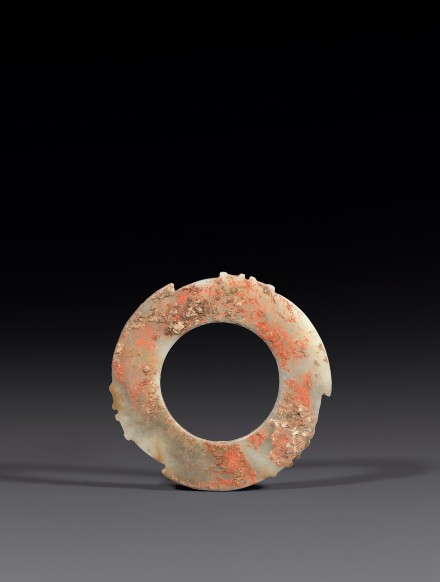J.J. Lally & Co., Oriental Art / New York City, New York
Menu
25.
A JADE NOTCHED DISC (YABI)
Late Neolithic Period/ Shang Dynasty, circa 2000 – 1500 B.C.
with wide central circular aperture, the narrow flat sides carved as three conjoined arcs, each rising to a wedge shaped point and with pairs of blunt notched teeth carved on each of the three arcs, all evenly spaced and symmetrically arranged around the outer rim, the inner rim plain and simply rounded, the pale grayish-white jade encrusted with cinnabar and burial earth.
Diameter 4 1⁄4 inches (10.8 cm)
This rare type of bi disc with notched and serrated rim was identified as a xuanji (璇璣) by the Chinese scholar-collector Wu Dacheng in his description of a similar notched disc illustrated in the catalogue of his collection, the Gu yu tu kao, published in 1889. Wu’s identification was based on his interpretation of a section of the Shangshu (Classic of History), a pre-Qin dynasty text containing a reference to a turning sphere (xuanji 璇璣) to be used in conjunction with a jade transverse sighting tube (yuheng 玉衡) for astronomical observations by court astronomers. This identification and description of the use of ancient jade notched discs was widely accepted and elaborated upon by Chinese and Western scholars during the following decades, but no archaeological evidence to support the theory has ever been found. Modern scholars, led by Xia Nai, have repudiated the theory and argued convincingly for the term xuanji to be abandoned and replaced by the term yabi (牙璧). See “The Classification, Nomenclature, and Usage of Shang Dynasty Jades” by Xia Nai, published in Kaogu, 1983, No. 5, pp. 455-467. The same monograph was presented by Xia at the International Conference on Shang Civilization, Hawaii, 1982, and is published in English by Chang (ed.), Studies of Shang Archaeology, New Haven, 1986, Chapter 9, pp. 207-236.
A slightly smaller jade yabi, with pairs of blunt notched teeth carved on each of the three arcs, excavated from a Longshan Culture (circa 3000-1700 B.C.) site at Tengxian, Shandong province, is illustrated by Xia, Kaogu xuebao, 1984, No. 4, pl. 2:1, with a stone example from a late Shang burial at Anyang, Henan province, loc. cit., pl. 1. The same jade yabi is illustrated in color in Zhongguo yuqi quanji (Compendium of Chinese Jades), Vol. 1, Primitive Society, Shijiazhuang, 1992, p. 34, col. pl. 42.
Another similar jade yabi in the collection of the Palace Museum, Beijing is illustrated in Gugong bowuyuan cang wenwu zhenpin quanji (The Complete Collection of Treasures of the Palace Museum), Jadeware (I), Hong Kong, 1995, p. 58, no. 49; and another similar yabi in the collection of the Kaifeng Museum is illustrated by Gu (ed.), Zhongguo chuanshi yuqi quanji (Chinese Jades in Traditional Collections), Vol. 1, Neolithic Period, Shang, Western Zhou, Spring and Autumn Period, Warring States Period, Beijing, 2010, p. 84.
Compare also the yabi of similar form in the Arthur M. Sackler Gallery, Washington D.C., illustrated in Asian Art in the Arthur M. Sackler Gallery, The Inaugural Gift, Washington, D.C., 1987, p. 89, no. 45; another illustrated by Loehr, Ancient Chinese Jades from the Grenville L. Winthrop Collection in the Fogg Art Museum, Harvard University, Cambridge, 1975, p. 103, no. 106; and another closely related jade yabi in the British Museum, illustrated by Rawson, Chinese Jade from the Neolithic to the Qing, London, 1995, p. 163, pl. 8:1.
For a comprehensive discussion of yabi discs excavated in China, see Luan, “Yabi yanjiu (Researches on Yabi),” Wenwu, 2005, No. 7, pp. 69-81.
新石器時代晚期 / 商 玉牙璧 徑 10.8 厘米
25.
A JADE NOTCHED DISC (YABI)
Late Neolithic Period/ Shang Dynasty, circa 2000 – 1500 B.C.
Diameter 4 1⁄4 inches (10.8 cm)